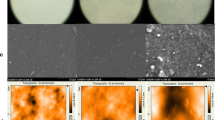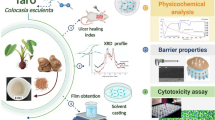Abstract
A novel wound dressing based on chitosan (CS) and gelatin (GL) was prepared and the effect of potato-starch (ST), sesame oil (SO) and banana peel powder (BPP) on the physical and mechanical properties, cytocompatibility and wound healing capability of the films were evaluated. The mechanical results showed that the samples containing 5 wt% of potato-starch and 7 wt% of banana peel powder had the best mechanical properties (Elastic Modulus of 1930 MPa and Tensile Strength of 58.2 MPa). The scanning electron micrographs presented the uniform distribution of banana peel powder within the polymeric matrix up to 7 wt% of banana peel powder. By Adding banana peel powder to the film composition, the antibacterial activity of the films against E. coli and S. aureus bacteria increased. The MTT assay results revealed that the films containing banana peel powder had no toxicity and never caused cell death. In vivo experiments, using an animal model, demonstrated that the proliferation of blood vessels and angiogenesis along with connective tissues formations were accelerated considerably by the samples prepared in this study.










Similar content being viewed by others

References
Liang D, Lu Z, Yang H, Gao J, Chen R (2016) Novel Asymmetric Wettable AgNPs/Chitosan Wound Dressing: In Vitro and In Vivo Evaluation. ACS Appl Mater Interfaces 8(6):3958–3968. https://doi.org/10.1021/acsami.5b11160
Venkataprasanna KS, Prakash J, Vignesh S, Bharath G, Venkatesan M, Banat F, Sahabudeen S, Ramachandran S, Devanand Venkatasubbu G (2020) Fabrication of Chitosan/PVA/GO/CuO patch for potential wound healing application. Int J Biol Macromol 143:744–762. https://doi.org/10.1016/j.ijbiomac.2019.10.029
Atiyeh BS, Gunn SW, Hayek SN (2005) State of the art in burn treatment. World J Surg 29(2):131–148. https://doi.org/10.1007/s00268-004-1082-2
Rujitanaroj P-o, Pimpha N, Supaphol P (2008) Wound-dressing materials with antibacterial activity from electrospun gelatin fiber mats containing silver nanoparticles. Polymer 49(21):4723–4732. https://doi.org/10.1016/j.polymer.2008.08.021
Boateng JS, Matthews KH, Stevens HN, Eccleston GM (2008) Wound healing dressings and drug delivery systems: a review. J Pharm Sci 97(8):2892–2923. https://doi.org/10.1002/jps.21210
Yusof NLBM, Wee A, Lim LY, Khor E (2003) Flexible chitin films as potential wound-dressing materials: wound model studies. J Biomed Mater Res 66:224–232. https://doi.org/10.1002/jbm.a.10545
Chen JP, Chang GY, Chen JK (2008) Electrospun collagen/chitosan nanofibrous membrane as wound dressing. Colloids Surf A Physicochem Eng Asp 313–314:183–188. https://doi.org/10.1016/j.colsurfa.2007.04.129
Akturk O, Tezcaner A, Bilgili H, Deveci MS, Gecit MR, Keskin D (2011) Evaluation of sericin/collagen membranes as prospective wound dressing biomaterial. J Biosci Bioeng 112(3):279–288. https://doi.org/10.1016/j.jbiosc.2011.05.014
Khil MS, Cha D-II, Kim HY, Kim IS, Bhattarai N (2003) Electrospun nanofibrous polyurethane membrane as wound dressing. J Biomed Mater Res Part B: Appl Biomater 67:675–679. https://doi.org/10.1002/jbm.b.10058
Balakrishnan B, Mohanty M, Fernandez AC, Mohanan PV, Jayakrishnan A (2006) Evaluation of the effect of incorporation of dibutyryl cyclic adenosine monophosphate in an in situ-forming hydrogel wound dressing based on oxidized alginate and gelatin. Biomaterials 27(8):1355–1361. https://doi.org/10.1016/j.biomaterials.2005.08.021
Verron E, Khairoun I, Guicheux J, Bouler JM (2010) Calcium phosphate biomaterials as bone drug delivery systems: a review. Drug Discov Today 15(13–14):547–552. https://doi.org/10.1016/j.drudis.2010.05.003
Friess W (1998) Collagen – biomaterial for drug delivery. Eur J Pharm Biopharm 45:113–136. https://doi.org/10.1016/S0939-6411(98)00017-4
Luo Y, Kirker KR, Prestwich GD (2000) Cross-linked hyaluronic acid hydrogel films new biomaterials for drug delivery. J Controlled Release 69:169–184. https://doi.org/10.1016/S0168-3659(00)00300-X
Zhang Z, Tan S, Feng SS (2012) Vitamin E TPGS as a molecular biomaterial for drug delivery. Biomaterials 33(19):4889–4906. https://doi.org/10.1016/j.biomaterials.2012.03.046
Chen YC, Lin RZ, Qi H, Yang Y, Bae H, Melero-Martin JM, Khademhosseini A (2012) Functional human vascular network generated in photocrosslinkable gelatin methacrylate hydrogels. Adv Funct Mater 22(10):2027–2039. https://doi.org/10.1002/adfm.201101662
Norotte C, Marga FS, Niklason LE, Forgacs G (2009) Scaffold-free vascular tissue engineering using bioprinting. Biomaterials 30(30):5910–5917. https://doi.org/10.1016/j.biomaterials.2009.06.034
Fuoco C, Sangalli E, Vono R, Testa S, Sacchetti B, Latronico MV, Bernardini S, Madeddu P, Cesareni G, Seliktar D, Rizzi R, Bearzi C, Cannata SM, Spinetti G, Gargioli C (2014) 3D hydrogel environment rejuvenates aged pericytes for skeletal muscle tissue engineering. Front Physiol 5:203. https://doi.org/10.3389/fphys.2014.00203
Perez RA, Won JE, Knowles JC, Kim HW (2013) Naturally and synthetic smart composite biomaterials for tissue regeneration. Adv Drug Deliv Rev 65(4):471–496. https://doi.org/10.1016/j.addr.2012.03.009
Jayakumar R, Prabaharan M, Sudheesh Kumar PT, Nair SV, Tamura H (2011) Biomaterials based on chitin and chitosan in wound dressing applications. Biotechnol Adv 29(3):322–337. https://doi.org/10.1016/j.biotechadv.2011.01.005
Bhattarai N, Gunn J, Zhang M (2010) Chitosan-based hydrogels for controlled, localized drug delivery. Adv Drug Deliv Rev 62(1):83–99. https://doi.org/10.1016/j.addr.2009.07.019
Mi FL, Shyu ShSh, Wu YB, Lee ST, Shyong JY, Huang RN (2001) Fabrication and characterization of a sponge-like asymmetric chitosan membrane as a wound dressing. Biomaterials 22:165–173. https://doi.org/10.1016/S0142-9612(00)00167-8
Liu X, Ma L, Mao Z, Gao C (2011) Chitosan-based biomaterials for tissue repair and regeneration 244:81–127. https://doi.org/10.1007/12_2011_118
No HK, Meyers SP, Prinyawiwatkul W, Xu Z (2007) Applications of chitosan for improvement of quality and shelf life of foods: a review. J Food Sci 72(5):R87-100. https://doi.org/10.1111/j.1750-3841.2007.00383.x
Chien PJ, Sheu F, Yang FH (2007) Effects of edible chitosan coating on quality and shelf life of sliced mango fruit. J Food Eng 78(1):225–229. https://doi.org/10.1016/j.jfoodeng.2005.09.022
Zeng D, Wu J, Kennedy JF (2008) Application of a chitosan flocculant to water treatment. Carbohyd Polym 71(1):135–139. https://doi.org/10.1016/j.carbpol.2007.07.039
Jimtaisong A, Saewan N (2014) Utilization of carboxymethyl chitosan in cosmetics. Int J Cosmet Sci 36(1):12–21. https://doi.org/10.1111/ics.12102
Oh DX, Hwang DS (2013) A biomimetic chitosan composite with improved mechanical properties in wet conditions. Biotechnol Prog 29(2):505–512. https://doi.org/10.1002/btpr.1691
Bourtoom T, Chinnan MS (2008) Preparation and properties of rice starch–chitosan blend biodegradable film. LWT - Food Sci Technol 41(9):1633–1641. https://doi.org/10.1016/j.lwt.2007.10.014
Chuang WY, Young TH, Yao ChH, Chiu WY (1999) Properties of the poly (vinyl alcohol)chitosan blend and its effect on the culture of fibroblast in vitro. Biomaterials 20:1479–1487. https://doi.org/10.1016/S0142-9612(99)00054-X
Chen F, Monnier X, Gällstedt M, Gedde UW, Hedenqvist MS (2014) Wheat gluten/chitosan blends: A new biobased material. Eur Polymer J 60:186–197. https://doi.org/10.1016/j.eurpolymj.2014.09.007
Kim S, Nimni ME, Yang Z, Han B (2005) Chitosan/gelatin-based films crosslinked by proanthocyanidin. J Biomed Mater Res B Appl Biomater 75(2):442–450. https://doi.org/10.1002/jbm.b.30324
Rubentheren V, Ward TA, Chee CY, Tang CK (2015) Processing and analysis of chitosan nanocomposites reinforced with chitin whiskers and tannic acid as a crosslinker. Carbohydr Polym 115:379–387. https://doi.org/10.1016/j.carbpol.2014.09.007
Chen AH, Liu SC, Chen CY, Chen CY (2008) Comparative adsorption of Cu(II), Zn(II), and Pb(II) ions in aqueous solution on the crosslinked chitosan with epichlorohydrin. J Hazard Mater 154(1–3):184–191. https://doi.org/10.1016/j.jhazmat.2007.10.009
Xu Y, Qiu C, Zhang X, Zhang W (2014) Crosslinking chitosan into H3PO4/HNO3-NANO2 oxidized cellulose fabrics as antibacterial-finished material. Carbohydr Polym 112:186–194. https://doi.org/10.1016/j.carbpol.2014.05.054
Ashori A, Bahrami R (2014) Modification of physico-mechanical properties of chitosan-tapioca starch blend films using nano graphene. Polym-Plast Technol Eng 53(3):312–318. https://doi.org/10.1080/03602559.2013.866246
Antoniou J, Liu F, Majeed H, Qi J, Yokoyama W, Zhong F (2015) Physicochemical and morphological properties of size-controlled chitosan–tripolyphosphate nanoparticles. Colloids Surf A Physiocochem Eng Asp 465:137–146. https://doi.org/10.1016/j.colsurfa.2014.10.040
Toivonen MS, Kurki-Suonio S, Schacher FH, Hietala S, Rojas OJ, Ikkala O (2015) Water-resistant, transparent hybrid nanopaper by physical cross-linking with chitosan. Biomacromol 16(3):1062–1071. https://doi.org/10.1021/acs.biomac.5b00145
Akhavan-Kharazian N, Izadi-Vasafi H (2019) Preparation and characterization of chitosan/gelatin/nanocrystalline cellulose/calcium peroxide films for potential wound dressing applications. Int J Biol Macromol 133:881–891. https://doi.org/10.1016/j.ijbiomac.2019.04.159
Mao JS, Liu HF, Yin YJ, Yao KD (2003) The properties of chitosan–gelatin membranes and scaffolds modified with hyaluronic acid by different methods. Biomaterials 24(9):1621–1629. https://doi.org/10.1016/s0142-9612(02)00549-5
Palma C, Contreras E, Urra J, Martínez MJ (2010) Eco-friendly technologies based on banana peel use for the decolourization of the dyeing process wastewater. Waste and Biomass Valorization 2(1):77–86. https://doi.org/10.1007/s12649-010-9052-4
Vilardi G, Di Palma L, Verdone N (2018) Heavy metals adsorption by banana peels micro-powder: Equilibrium modeling by non-linear models. Chin J Chem Eng 26(3):455–464. https://doi.org/10.1016/j.cjche.2017.06.026
Mahindrakar KV, Rathod VK (2018) Utilization of banana peels for removal of strontium (II) from water. Environ Technol Innov 11:371–383. https://doi.org/10.1016/j.eti.2018.06.015
Happi Emaga T, Ronkart SN, Robert C, Wathelet B, Paquot M (2008) Characterisation of pectins extracted from banana peels (Musa AAA) under different conditions using an experimental design. Food Chem 108(2):463–471. https://doi.org/10.1016/j.foodchem.2007.10.078
Kamel NA, Abd El-Messieh SL, Saleh NM (2017) Chitosan/banana peel powder nanocomposites for wound dressing application: Preparation and characterization. Mater Sci Eng C Mater Biol Appl 72:543–550. https://doi.org/10.1016/j.msec.2016.11.104
Tunde-Akintunde TY, Akintunde BO (2004) Some physical properties of sesame seed. Biosys Eng 88(1):127–129. https://doi.org/10.1016/j.biosystemseng.2004.01.009
Jan KC, Ho CT, Hwang LS (2009) Elimination and metabolism of sesamol, a bioactive compound in sesame oil, in rats. Mol Nutr Food Res 53(Suppl 1):S36-43. https://doi.org/10.1002/mnfr.200800214
ASTM (2005) Standard test method for water vapor transmission of materials (E96–05). PA, USA, Philadelphia
ASTM (2009) Standard test method for tensile properties of thin plastic sheeting (D882–09). PA, USA, Philadelphia
CLSI (2012) Performance standards for antimicrobial disk susceptibility tests, approved standard, 7th ed., CLSI document M02-A11. Clinical and Laboratory Standards Institute, 950 West Valley Road, Suite 2500, Wayne, Pennsylvania 19087, USA
Fotakis G, Timbrell JA (2006) In vitro cytotoxicity assays: comparison of LDH, neutral red, MTT and protein assay in hepatoma cell lines following exposure to cadmium chloride. Toxicol Lett 160(2):171–177. https://doi.org/10.1016/j.toxlet.2005.07.001
Loo Y, Wong YC, Cai EZ, Ang CH, Raju A, Lakshmanan A, Koh AG, Zhou HJ, Lim TC, Moochhala SM, Hauser CA (2014) Ultrashort peptide nanofibrous hydrogels for the acceleration of healing of burn wounds. Biomaterials 35(17):4805–4814. https://doi.org/10.1016/j.biomaterials.2014.02.047
Alsarra IA (2009) Chitosan topical gel formulation in the management of burn wounds. Int J Biol Macromol 45(1):16–21. https://doi.org/10.1016/j.ijbiomac.2009.03.010
Fakhreddin Hosseini S, Rezaei M, Zandi M, Ghavi FF (2013) Preparation and functional properties of fish gelatin-chitosan blend edible films. Food Chem 136(3–4):1490–1495. https://doi.org/10.1016/j.foodchem.2012.09.081
Staroszczyk H, Pielichowska J, Sztuka K, Stangret J, Kołodziejska I (2012) Molecular and structural characteristics of cod gelatin films modified with EDC and TGase. Food Chem 130(2):335–343. https://doi.org/10.1016/j.foodchem.2011.07.047
Kizil R, Irudayaraj J, Seetharaman K (2002) Characterization of irradiated starches by using FT-Raman and FTIR Spectroscopy. J Agric Food Chem 50:3912–3918. https://doi.org/10.1021/jf011652p
Deng DH, Xu L, Ye ZH, Cui HF, Cai C-B, Yu X-P (2012) FTIR Spectroscopy and chemometric class modeling techniques for authentication of Chinese sesame oil. J Am Oil Chem Soc 89(6):1003–1009. https://doi.org/10.1007/s11746-011-2004-8
Alaa El-Din G, Amer AA, Malsh G, Hussein M (2018) Study on the use of banana peels for oil spill removal. Alex Eng J 57(3):2061–2068. https://doi.org/10.1016/j.aej.2017.05.020
Yi H, Wu LQ, Bentley WE, Ghodssi R, Rubloff GW, Culver JN, Payne GF (2005) Biofabrication with chitosan. Biomacromol 6:2881–2894. https://doi.org/10.1021/bm050410l
Ma B, Qin A, Li X, Zhao X, He C (2014) Structure and properties of chitin whisker reinforced chitosan membranes. Int J Biol Macromol 64:341–346. https://doi.org/10.1016/j.ijbiomac.2013.12.015
Pereda M, Ponce AG, Marcovich NE, Ruseckaite RA, Martucci JF (2011) Chitosan-gelatin composites and bi-layer films with potential antimicrobial activity. Food Hydrocoll 25(5):1372–1381. https://doi.org/10.1016/j.foodhyd.2011.01.001
Devlieghere F, Vermeulen A, Debevere J (2004) Chitosan: antimicrobial activity, interactions with food components and applicability as a coating on fruit and vegetables. Food Microbiol 21(6):703–714. https://doi.org/10.1016/j.fm.2004.02.008
Mokbel MS, Hashinaga F (2005) Antibacterial and antioxidant activities of banana (Musa, AAA cv. Cavendish) fruits peel. Am J Biochem Biotechnol 1:125–131. https://doi.org/10.3844/ajbbsp.2005.125.131
Boots AW, Haenen GR, Bast A (2008) Health effects of quercetin: from antioxidant to nutraceutical. Eur J Pharmacol 585(2–3):325–337. https://doi.org/10.1016/j.ejphar.2008.03.008
Cheng JC, Dai F, Zhou B, Yang L, Liu ZL (2007) Antioxidant activity of hydroxycinnamic acid derivatives in human low density lipoprotein: Mechanism and structure–activity relationship. Food Chem 104(1):132–139. https://doi.org/10.1016/j.foodchem.2006.11.012
Vu HT, Scarlett CJ, Vuong QV (2018) Phenolic compounds within banana peel and their potential uses: A review. J Funct Foods 40:238–248. https://doi.org/10.1016/j.jff.2017.11.006
Author information
Authors and Affiliations
Corresponding author
Additional information
Publisher’s Note
Springer Nature remains neutral with regard to jurisdictional claims in published maps and institutional affiliations.
Rights and permissions
About this article
Cite this article
Alborzi, Z., Izadi-Vasafi, H. & Ghayoumi, F. Wound dressings based on chitosan and gelatin containing starch, sesame oil and banana peel powder for the treatment of skin burn wounds. J Polym Res 28, 61 (2021). https://doi.org/10.1007/s10965-021-02427-y
Received:
Accepted:
Published:
DOI: https://doi.org/10.1007/s10965-021-02427-y



